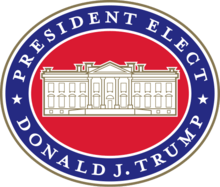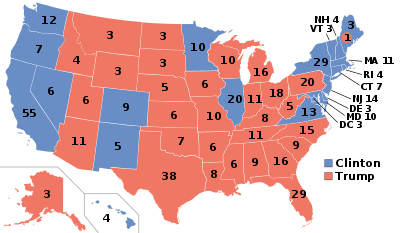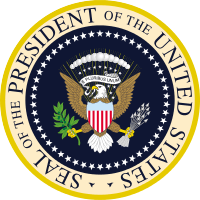Presidency of Donald Trump
| ||
|---|---|---|
|
President of the United States
Real estate
Golf courses Other ventures  |
||
The Presidency of Donald Trump is scheduled to begin at noon EST on January 20, 2017, when Trump will become the 45th President of the United States upon his inauguration,[1] to follow the presidency of Barack Obama. Trump, a Republican, was a businessman from New York at the time of his victory in the 2016 presidential election over Democrat Hillary Clinton. His running mate, Governor Mike Pence of Indiana, will take office as Vice President on the same day. At age 70, Trump will be the oldest person to take office as president,[2] though Ronald Reagan left office at the age of 77. Trump's term in office is set to end on January 20, 2021, but Trump is eligible to run for re-election in the 2020 presidential election.
Transition period and inauguration
Prior to the election, Trump named Chris Christie as the leader of his transition team.[3] After the election, Vice President-elect Mike Pence replaced Christie as chairman of the transition team, while Christie became a vice-chairman of the transition alongside Senator Jeff Sessions of Alabama, retired Army Lt. Gen. Mike Flynn, former New York City Mayor Rudy Giuliani, former presidential candidate Ben Carson, and former House Speaker Newt Gingrich.[4] Trump's transition team has launched a website called Greatagain.gov.[5] Trump and his transition team began choosing key personnel for his administration following his election victory.[6]
On November 13, Trump announced that he had chosen Republican National Committee Chairman Reince Priebus as White House Chief of Staff, and former Breitbart News Chairman Steve Bannon as Counselor to the President.[7] Subsequent picks were retired Lt Gen Michael T. Flynn for National Security Advisor, Jeff Sessions for Attorney General, Mike Pompeo for CIA director, Nikki Haley as Ambassador to the UN, Betsy DeVos as Education Secretary, Donald F. McGahn II as White House Counsel, Kathleen Troia McFarland as Deputy National Security Advisor,[8] Tom Price for Health and Human Services, Elaine Chao for Transportation,[9] Steven Mnuchin at Treasury, and Wilbur Ross at Commerce.[10]
During the transition period, Trump did not separate his business dealings from his work as President-Elect. According to Noah Bookbinder of Citizens for Responsibility and Ethics, "there does not seem to be any sign of a meaningful separation of Trump government operations and his business operations."[11]
Personnel
Cabinet
Days after the presidential election, Trump announced that he had selected RNC Chairman Reince Preibus as his Chief of Staff, a position that does not require Senate confirmation.[7] Aside from the vice presidency, the remaining Cabinet and Cabinet-level positions require Senate confirmation. On November 18, Trump announced his first Cabinet designee, choosing Alabama Senator Jeff Sessions for the position of Attorney General.[12]
Notable non-Cabinet positions
¶ White House staff |
¶ Security and international affairs |
¶ Domestic affairs
|
¶ Federal Reserve Board
|
1Appointed by Barack Obama
2Pending Senate confirmation
Judicial nominees
Trump will likely take office with a Supreme Court vacancy, which arose after the February 2016 death of Antonin Scalia. During his campaign, Trump released two lists of potential nominees to fill the vacancy caused by Scalia's death.[13] Additionally, the United States Courts of Appeals have several vacancies and the United States District Courts have dozen of vacancies for the incoming president to fill.[14]
First 100 days
The first 100 days of Donald Trump's presidency are scheduled to begin with his inauguration on January 20, 2017, and will last until April 29, 2017. The first 100 days of a presidential term took on symbolic significance during Franklin D. Roosevelt's administration, and the period is considered a benchmark to measure the early success of a president.
Policies
Domestic policy
Economy
Shortly before Trump's election, the United States had an unemployment rate of 4.9% and a Federal Reserve-projected GDP growth rate of 1.8% for 2016 (adjusted for inflation).[15] With a GDP of $17.9 trillion according to a 2015 World Bank estimate, the US represented just under a quarter of the GDP of the world economy.[16]
After eight days as President-Elect, Trump claimed credit for persuading a Ford plant in Kentucky from moving to Mexico. However, Ford had never indicated that it was going to close the plant, and the workers' union confirmed that no jobs had been at stake at the plant.[17][18]
Taxation
During the 2016 campaign, Trump promised major federal tax cuts.[19] Trump's plan called for a move from seven income tax brackets to three, cutting rates and lowering the top bracket from $415,050 to $112,500.[19] Trump's plan would also cut the corporate tax rate from 35 percent to 15 percent and eliminate the estate tax.[19]
Health care
The 2010 Patient Protection and Affordable Care Act (also known as "Obamacare") elicited major opposition from the Republican Party from its inception, and Trump called for a repeal of the law during the 2016 election campaign.[20] However, Trump has also called for leaving some provisions of the law intact, including a ban on denying coverage to those with pre-existing conditions.[21]
Environment
During the 2016 campaign, Trump expressed skepticism about the existence of global warming, and Trump may seek to remove the United States from the Paris Agreement, a 2015 climate change accord reached by 200 nations.[22]
Immigration
Prior to taking office, Trump promised to deport the 11 million illegal immigrants living in the United States and to build a wall along the Mexico–United States border.[23]
Foreign policy
Afghanistan
Trump is expected to take office while the United States remains involved in the War in Afghanistan, which began in 2001 and is the longest war in American history.[24] President Obama plans to have 8,400 soldiers deployed in Afghanistan at the end of his term, with the soldiers focused on training and counter-terrorism operations.[25]
Iraq and Syria
Trump is expected to take office while the United States remains involved in a military intervention against ISIL (also known as ISIS, the Islamic State or Daesh), a Salafi jidahist unrecognized state that gained control of parts of Iraq and Syria following the outbreak of the Syrian Civil War.[26] There were roughly 4,500 American soldiers in Iraq as of February 2016.[27] Under Obama, the United States has also backed non-ISIS forces opposed to Syrian President Bashar al-Assad in the Syrian Civil War.[28]
China
During the transition phase, Trump became the first president or president-elect since 1979 to speak directly to the President of Taiwan.[29] This called into question whether President Trump will continue to follow the long-standing One-China policy followed by the United States regarding the political status of Taiwan.[29]
Trade agreements
During the 2016 campaign, Trump called for a re-negotiation of free trade agreements, including NAFTA, a free trade agreement among the United States, Canada, and Mexico that entered into force in 1994.[30] Trump also strongly opposed the Trans-Pacific Partnership, a proposed free trade agreement among several nations that border the Pacific Ocean.[30]
Ethics
Lobbying reform
During the 2016 campaign, Trump promised to "drain the swamp in Washington D.C.", and he proposed a series of ethics reforms.[31] Among his proposals was a five-year ban on serving as a lobbyist after working in the executive branch.[31] Trump's transition team also announced that registered lobbyists would be barred from serving in the Trump administration.[32]
Approval ratings
At the time of the 2016 election, Gallup polls found Trump with a favorable rating around 35% and an unfavorable rating around 60%.[33] His favorable rating jumped to 42% in the days following the election, while his unfavorable rating dropped to 55%.[34]
Elections
2016 elections

Taking place in the final months of President Barack Obama's second term, the 2016 election saw the Republican ticket of businessman Donald Trump of New York and Governor Mike Pence of Indiana defeat the Democratic ticket of former Secretary of State Hillary Clinton of New York and Senator Tim Kaine of Virginia. Assuming no faithless electors, Trump won 306 electoral votes compared to Clinton's 232, though Clinton won a plurality of the popular vote.[35] Trump is the fifth person to win the electoral vote but lose the popular vote, after John Quincy Adams (1824), Rutherford B. Hayes (1876), Benjamin Harrison (1888), and George W. Bush (2000). Although Republicans lost a net of 2 seats in the Senate elections and 6 seats in the House elections, they maintained their majorities in both houses for the 115th Congress.[36] The election gave Republicans unified control of Congress and the presidency for the first time since the 2006 elections. After the election, Republican Mitch McConnell of Kentucky retained his position as Senate Majority Leader, while Democrat Chuck Schumer of New York replaced the retiring Harry Reid as Senate Minority Leader.[37] Democrat Nancy Pelosi retained her position as House Minority Leader,[38] and Paul Ryan is expected to retain his position as Speaker of the House.[39]
2018 midterm elections
Midterm elections will be held on November 6, 2018. All 435 House seats and one third of the Senate will be up for election.
See also
References
- ↑ La Miere, Jason (9 November 2016). "President Obama Speech Live Stream: Donald Trump's Election Win To Be Addressed In Statement". International Business Times.
- ↑ "Donald Trump is oldest president elected in US history". Business Insider. 2016-11-09. Retrieved 2016-11-10.
- ↑ Bender, Michael C. (2016-11-10). "Donald Trump Transition Team Planning First Months in Office". WSJ. Retrieved 2016-11-10.
- ↑ "Pence will lead Trump transition". CNN. Retrieved November 11, 2016.
- ↑ Lawler, Richard (November 9, 2016). "Donald Trump's 'Transition Team' launches GreatAgain.gov". Engadget. Retrieved November 11, 2016.
- ↑ Stephenson, Emily; Holland, Steve (16 November 2016). "Trump shuffles transition team, eyes loyalists for Cabinet". Reuters. Retrieved 16 November 2016.
- 1 2 Shear, Michael; Haberman, Maggie; Rappeport, Alan (13 November 2016). "Donald Trump Picks Reince Priebus as Chief of Staff and Stephen Bannon as Strategist". New York Times. Retrieved 14 November 2016.
- ↑ "McFarland, McGahn to join Trump administration". Retrieved 28 Nov 2016.
- ↑ "Trump adds to cabinet with Caho, Price". Retrieved 29 Nov 2016.
- ↑ "A Look at Trump's Cabinet Picks". Retrieved 30 Nov 2016.
- ↑ Lipton, Eric; Barry, Ellen. "Donald Trump Meeting Suggests He Is Keeping Up His Business Ties - NYTimes.com". Retrieved 2016-11-20.
- ↑ Stokols, Eli (18 November 2016). "What Trump's early picks say about his administration". Politico. Retrieved 18 November 2016.
- ↑ Jeremy Diamond, Ariane de Vogue and Ashley Killough, "Trump floats more potential Supreme Court picks — including Sen. Mike Lee", CNN (September 23, 2016).
- ↑ "Judicial Vacancies". United States Courts. Retrieved 14 November 2016.
- ↑ Sherter, Alain (4 October 2016). "Politics aside, here's how the U.S. economy is really doing". CBS news. Retrieved 16 November 2016.
- ↑ "GDP (current US$)" (PDF). World Development Indicators. World Bank. Retrieved 2 July 2016.
- ↑ "Trump just took credit for stopping Ford from moving a plant to Mexico. But it wasn't planning to.". Washington Post. Retrieved 2016-11-18.
- ↑ Appelbaum, Binyamin (2016-11-18). "Donald Trump Takes Credit for Helping to Save a Ford Plant That Wasn't Closing". The New York Times. ISSN 0362-4331. Retrieved 2016-11-18.
- 1 2 3 Ydstie, John (13 November 2016). "Who Benefits From Donald Trump's Tax Plan?". NPR. Retrieved 18 November 2016.
- ↑ Haberkorn, Jennifer (9 November 2016). "Trump victory puts Obamacare dismantling within reach". Politico. Retrieved 18 November 2016.
- ↑ "Trump: Obamacare key provisions to remain". BBC. 12 November 2016. Retrieved 18 November 2016.
- ↑ Volcovici, Valerie; Doyle, Alister (14 November 2016). "Trump looking at fast ways to quit global climate deal: source". Reuters. Retrieved 18 November 2016.
- ↑ Tareen, Sophia (18 November 2016). "Trump's election triggers flood of immigration questions". Christian Science Monitor. Retrieved 18 November 2016.
- ↑ Welna, David (12 September 2016). "New President Will Inherit The War In Afghanistan". NPR. Retrieved 16 November 2016.
- ↑ Landler, Mark (July 6, 2016). "Obama Says He Will Keep More Troops in Afghanistan Than Planned". New York Times. Retrieved July 7, 2016.
- ↑ "What is 'Islamic State'?". BBC. 2 December 2015. Retrieved 16 November 2016.
- ↑ Youssef, Nancy A. (February 2, 2016). "Pentagon Won't Say How Many Troops Are Fighting ISIS". The Daily Beast. Retrieved May 15, 2016.
Officially, there are now 3,650 U.S. troops in Iraq, there primarily to help train the Iraqi national army. But in reality, there are already about 4,450 U.S. troops in Iraq, plus another nearly 7,000 contractors supporting the American government’s operations.
- ↑ Chan, Sewell; Saad, Hwaida (16 November 2016). "Syrian President Calls Donald Trump a 'Natural Ally' in Fight Against Terrorism". New York Times. Retrieved 16 November 2016.
- 1 2 Crowley, Michael (2 December 2016). "Bull in a China shop: Trump risks diplomatic blowup in Asia". Politico. Retrieved 3 December 2016.
- 1 2 Blake, Paul (11 November 2016). "Trump and Trade: How the President-Elect Could Tear Up TPP and Nix NAFTA". ABC News. Retrieved 18 November 2016.
- 1 2 Schrekinger, Ben (17 October 2016). "Trump proposes ethics reforms". Politico. Retrieved 18 November 2016.
- ↑ Ho, Catherine (16 November 2016). "Trump administration will ban lobbyists, enact five-year lobbying ban after leaving government". Washington Post. Retrieved 18 November 2016.
- ↑ "Presidential Election 2016: Key Indicators". Gallup. Retrieved 15 November 2016.
- ↑ Flores, Reena (17 November 2016). "Poll: Trump's favorability jumps but still lags other presidents-elect". CBS News. Retrieved 17 November 2016.
- ↑ "2016 U.S. General Election". Associated Press. Retrieved November 10, 2016.
- ↑ Jagoda, Naomi (10 November 2016). "Election result opens door for tax reform legislation". The Hill. Retrieved 14 November 2016.
- ↑ Barrett, Ted; LoBianco, Tom; Zeleny, Jeff (16 November 2016). "McConnell, Schumer elected to top spots in Senate ahead of battles with Trump". CNN. Retrieved 17 November 2016.
- ↑ Parks, Maryalice; Saenz, Arlette (30 November 2016). "Nancy Pelosi Wins Re-Election as House Democratic Leader". ABC News. Retrieved 4 December 2016.
- ↑ Siegel, Benjamin (15 November 2016). "Paul Ryan Poised to Remain Speaker After Closed-Door Vote". ABC News. Retrieved 4 December 2016.
| U.S. Presidential Administrations | ||
|---|---|---|
| Preceded by Obama |
Trump Presidency Starting 2017 |
Succeeded by – |



